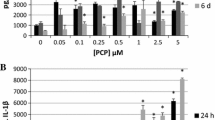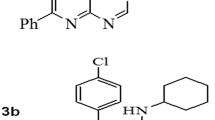Abstract
A wide variety of immunosuppressive effects of 2,3,7,8-tetrachlorodibenzo-p-dioxin (TCDD) in experimental animals has been documented. In contrast, the impact of dioxin on the human immune system remains controversial, although adverse health effects have been reported in humans after occupational or accidental exposure to dioxin. Recently, Neubert et al. (1991) found that a dose-dependent decrease of peripheral blood lymphocyte (PBL) subpopulations in humans and non-human primates, including helper-inducer/memory cells (CD4+CD29+) and B cells (CD20+) occurred in pokeweed mitogen (PWM) stimulated cultures at concentrations as low as 10−12–10−14 M TCDD. Therefore, the direct effects of dioxin on human PBL subpopulations have been studied, in order to determine their usefulness as sensitive biomarkers for human dioxin exposure. Lymphocyte cultures from healthy individuals were treated with 10−7 M–10−14 M TCDD in the absence and presence of stimulation with pokeweed mitogen (PWM) or anti-CD3 monoclonal antibody (moAb; OKT3) for 3 days. Cytochrome P450 (CYP1A1) enzyme induction, one of the best studied direct biological effects of TCDD on numerous cell types, was assayed in parallel by ethoxyresorufin-O-deethylase (EROD) activity. Percentages of the different lymphocytes subsets, including CD2 (T cells); CD4; CD45 RA (suppressor-inducer/virgin T cells); CD4 CD29; CD8; CD19 (B cells) as well as interleukin 2 (IL-2) receptor (CD25) and class II antigen (HLA-DR) expression, were anlayzed by flow cytometry. DNA synthesis was determined by3H-thymidine uptake after 3 days of culture. In the present study, all stimulated lymphocyte cultures showed a dose-dependent significant increase of CYP1A1 activity at dioxin concentrations of 10−7 and 10−9 M. No enzyme activity could be detected at lower concentrations of TCDD. On the other hand, neither alteration in surface marker distribution nor suppression of lymphocyte proliferation could be demonstrated in mitogen-activated cells following any concentration of TCDD treatment. These data suggest that the inducibility of CYP1A1 enzyme activity is not correlated with direct immunotoxic effects in vitro in human PBL. In contrast to a previous report by Neubert et al. (1991), lymphoproliferation and phenotypes of human PBL are resistant to dioxin exposure in vitro and therefore appeared not to be useful as sensitive biomarkers in human exposure studies.
Similar content being viewed by others
References
Bekesi JG, Holland JF, Anderson HA et al. (1978) Lymphocyte function of Michigan dairy farmers exposed to polybrominated biphenyls. Science 199: 1207–1209
Birnbaum LS (1994) The mechanism of dioxin toxicity: relationship to risk assessment. Environ Health Perspect (in press)
Boyum A (1968) Isolation of mononuclear cells and granulocytes from human blood. Scand J Clin Lab Invest 21: 77–89
Chang K-J, Hsieh K-H, Lee T-P, Tang S-Y, Tung T-C (1981) Immunologic evaluation of patients with polychlorinated biphenyl poisoning: determination of lymphocyte subpopulations. Toxicol Appl Pharmacol 61: 58–63
Chang K-J, Hsieh K-H, Tang S-Y, Tung T-C, Lee T-P (1982) Immunologic evaluation of patients with polychlorinated biphenyl poisoning: evaluation of delayed-type skin hypersensitivity response and its relation to clinical studies. J Toxicol Environ Health 9: 217–223
Clark G, Poland A, Glover E, McCoy Z, Lucier G (1992a) Expression of the Ah receptor in human peripheral blood lymphocytes. In: Organohalogen compounds, volume 10: Toxicology, epidemiology, risk assessment and management. Finnish Institute of Occupational Health, Helsinki, poster presentation at the 12th International Symposium on Dioxins and Related Compounds, Tampere, Finland
Clark G, Tritscher A, Bell D, Lucier G (1992b) Integrated approach for evaluating species and interindividual differences in responsiveness to dioxins and structural analogs. Environ Perspect 98: 125–132
Cook JC, Greenlee WF (1989) Characterization of a specific binding protein for 2,3,7,8-tetrachlorodibenzo-p-dioxin in human thymic epithelial cells. Mol Pharmacol 35: 713–719
Cook JC, Dold KM, Greenlee WF (1987) An in vitro model for studying the toxicity of 2,3,7,8-tetrachlorodibenzo-p-dioxin to human thymus. Toxicol Appl Pharmacol 89: 256–268
Dean JH, Cornacoff JB, Luster MI (1990) Toxicity to the immune system: a review. In: Hadden JW, Szentivanyi A (eds) Immunopharmacology review, vol. 1. Plenum, New York, pp 377–408
Dencker L, Hassouin E, D’Argy R, Alm G (1985) Fetal thymus organ culture as an in vitro model for the toxicity of 2,3,7,8-tetrachlorodibenzo-p-dioxin and its congeners. Mol Pharmacol 27: 133–140
Gaido KW, Leonard LS, Maness SC, Andersen ME (1991) TCDD-dependent regulation of gene expression in human keratinocytes. CIIT Activities 11: 1–10
Hoffman RE, Stehr-Green PA, Webb KB, Evans RG, Knutsen AP, Schramm WF, Staake JF, Gibson BB, Steinberg KK (1986) Health effects of longterm exposure to 2,3,7,8-tetrachlorodibenzo-p-dioxin. JAMA 255: 2031–2038
Holsapple MP, Dooley RK, McNerney PJ, McCay JA (1986) Direct suppression of antibody responses by chlorinated dibenzodioxins in cultured spleen cells from (C57BL/6xC3H)F1 and DBA/2 mice. Immunopharmacology 12: 175–186
Holsapple MP, Morris DL, Wood SC, Snyder NK (1991) 2,3,7,8-Tetrachlorodibenzo-p-dioxin-induced changes in immunocompetence: possible mechanisms. Annu Rev Pharmacol Toxicol 31: 73–100
Hong R, Taylor K, Abonour R (1989) Immune abnormalities with chronic TCDD exposure in Rhesus. Chem 18: 313–320
Jennings AM, Wild G, Ward JD, Ward AM (1988) Immunological abnormalities 17 years after accidental exposure to 2,3,7,8-tetrachlorodibenzo-p-dioxin. BMJ 45: 701–704
Johnson ES (1992) Human exposure to 2,3,7,8-TCDD and risk of cancer. Crit Rev Toxicol 21: 451–463
Kawamoto T, Matsumura F (1989) Effects of TCDD on the EGF receptor of XB mouse keratinizing epithelial cells. J Biochem Toxicol 4: 173–183
Kervliet NI, Brauner JA (1990) Flow cytometric analysis of lymphocyte subpopulations in the spleen and thymus of mice exposed to an acute immunosuppressive dose of 2,3,7,8-tetrachlorodibenzo-p-dioxin (TCDD). Environ Res 52: 146–154
Knutsen AP (1984) Immunologic effects of TCDD exposure in humans. Bull Environ Contam Toxicol 33: 673–681
Kochman S, Cazabat JBA, Lavaud F, Lorton C, Rappe C (1986) Phenotypical dissection of immunoregulatory T cell subsets in human after furan exposure. Chem 15: 9–12
Kouri RE, Ratrie III H, Atlas SA, Niwa A, Nebert DW (1974) Aryl hydrocarbon hydroxylase induction in human lymphocyte cultures bt 2,3,7,8-tetrachlordibenzo-p-dioxin. Life Sci 15: 1585–1595
Krishan A (1975) Rapid flow cytofluorometric analysis of mammalian cell cycle by propidium iodide staining. J Cell Biol 66: 188–193
Lorenzen A, Okey AB (1991) Detection and characterization of Ah receptor in tissues and cells from human tonsils. Toxicol Pharmacol 107: 203–214
Lundberg K, Dencker L, Grönvik K-O (1990) Effects of 2,3,7,8-tetrachlorodibenzo-p-dioxin (TCDD) treatment in vivo on thymocyte functions in mice after activation in vivo. Int J Immunopharmacol 12: 459–466
Lundberg K, Dencker L, Grönvik K-O (1992) 2,3,7,8-Tetrachlorodibenzo-p-dioxin (TCDD) inhibits the activation of antigen-specific T-cells in mice. Int J Immunopharmacol 14: 699–705
Luster MI, Boorman GA, Dean JH, Harris MW, Luebke RW, Padarathsingh ML, Moore JA (1980) Examination of bone marrow, immunologic parameters and host susceptibility following prepostnatal exposure to 2,3,7,8-tetrachlorodibenzo-p-dioxin (TCDD). Int J Immunopharmacol 2: 301–310
Nebert DW (1989) The Ah locus: genetic differences in toxicity, cancer, mutation, and birth defects. CRC Crit Rev Toxicol 20: 153–174
Neubert R, Jacob-Müller U, Stahlmann R, Neubert D (1991) Polyhalogenated dibenzo-p-dioxins and dibenzofurans and the immune system. 1. Effects on peripheral lymphocyte subpopulations of a non-human primate (Callithrix jacchus) after treatment with 2,3,7,8-tetrachlorodibenzo-p-dioxin (TCDD). Arch Toxicol 64: 345–359
Neubert R, Jacob-Müller U, Helge H, Stahlmann R, Neubert D (1991) Polyhalogenated dibenzo-p-dioxins and dibenzofurans and the immune system. 2. In vitro effects of 2,3,7,8-tetrachlorodibenzo-p-dioxin (TCDD) on lymphocytes of venous blood from man and a non-human primate (Callithrix jacchus). Arch Toxicol 65: 213–219
Neubert R, Golor G, Stahlmann, R, Helge H, Neubert D (1992) Polyhalogenated dibenzo-p-dioxins and dibenzofurans and the immune system. 4. Effects of multiple-dose treatment with 2,3,7,8-tetrachlorodibenzo-p-dioxin (TCDD) on peripheral lymphocyte subpopulations of a non-human primate (Callithrix jacchus). Arch Toxicol 66: 250–259
Pohl RJ, Fouts JR (1980) A rapid method for assaying the metabolism of 7-ethoxyresorufin by microsomal subcellular fractions. Anal Biochem 107: 150–155
Poiger H, Schlatter Ch (1983) Animal toxicology of chlorinated dibenzo-p-dioxins. Chem 12: 453–462
Puhvel SM, Sakamoto M (1988) Effect of 2,3,7,8-tetrachlorodibenzo-p-dioxin on murine skin. J Invest Dermatol 30: 354–358
Silbergeld EK (1991) Dioxin: a case study in chloracne. In: Marzulli FN, Maibach HI (eds.) Dermatotoxicology. Hemisphere, New York, pp 667–686
Silva JA, Kaufman CA, Simon DG et al. (1979) Lymphocyte function in humans exposed to polybrominated biphenyls. J Retic Soc 26: 341–347
Taylor MJ, Lucier GW, Mahler JF, Thompson M, Lockhart AC, Clark GC (1992) Toxicol Appl Pharmacol 117: 126–132
Tognoni G, Bonaccorsi A (1982) Epidemiological problems with TCDD (a critical review). Drug Metab Rev 13: 447–469
Tomar RS, Kerkvliet NI (1991) Reduced T-helper cell function in mice exposed to 2,3,7,8-tetrachlorodibenzo-p-dioxin (TCDD). Toxicol Lett 57: 55–64
Tucker AN, Vore SJ, Luster MI (1986) Suppression of B cell differentiation by 2,3,7,8-tetrachlorodibenzo-p-dioxin. Mol Pharmacol 29: 372–377
Whitlock Jr JP (1990) Genetic and molecular aspects of 2,3,7,8-tetrachlorodibenzo-p-dioxin action. Annu Rev Pharmacol Toxicol 30: 251–277
Wood SC, Karras JG, Holsapple MP (1992) Integration of the human lymphocyte into immunotoxicological investigations. Fundam Appl Toxicol 18: 450–459
Wu Y-C, Hsieh R-P, Lü Y-C (1984) Altered distribution of lymphocyte subpopulations and augmentation of lymphocyte proliferation in chronic PCB poisoned patients. Chin J Microbiol Immunol 17: 177–187
Zola H (1987) The surface antigens of human B lymphocytes. Immunol T Today 8: 308–315
Author information
Authors and Affiliations
Additional information
The research described in this article has been reviewed by the Health Effects Research Laboratory, US Environmental Protection Agency, and apporved for puplication. Approval, does not signify that the contents reflect the views and policies of the Agency, nor does mention of trade names or commercial products consitute endorsement of recommendation for use.
Rights and permissions
About this article
Cite this article
Lang, D.S., Becker, S., Clark, G.C. et al. Lack of direct immunosuppressive effects of 2,3,7,8-tetrachlorodibenzo-p-dioxin (TCDD) on human peripheral blood lymphocyte subsets in vitro. Arch Toxicol 68, 296–302 (1994). https://doi.org/10.1007/s002040050072
Issue Date:
DOI: https://doi.org/10.1007/s002040050072




